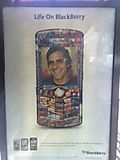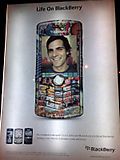LTE surely is an exciting new radio technology and over time will become a worthy successor to GSM and UMTS. It will have a difficult start though, as it is lacking intrinsic support for the wireless killer application, voice calls. A number of different efforts are underway in 3GPP to fix this. I've reported before on IMS Centralized Services, which is elegant but unfortunately quite complex and CS Voice Services over LTE, which from my point of view would fix things with an acceptable amount of effort and complexity but is currently met with little love in the standards body.
A third initiative that, unlike CS Voice over LTE, has manged to become an active work item in 3GPP is to let the mobile device fall back to GSM or UMTS for incoming and outgoing voice calls. In 3GPP the technical specification that contains an overview of the feature is TS 23.272 'Circuit Switched (CS) fallback in Evolved Packet System (EPS)'.
From an overall architectural point of view I think this work item is rather a confession that there is still a long way to go until we have a real successor technology in place for voice. However, if it can do the job, who cares…
The technical specification of the feature is refreshingly clear how it is supposed to work. For those of you who don't want to go through the spec, here's a short overview of how things will work:
The Preparation Phase
- When the GSM/UMTS/LTE capable device first connects to the EPS (the Evolved Packet System, i.e. to LTE), it indicates to the network that it wants to perform a "Combined Update". In practice this means that it requests from the network to also register its presence in the 2G/3G circuit switched network.
- Registration of the mobile in the 2G/3G network is performed on behalf of the mobile device by the MME (Mobility Management Entity) network element which is part of the Access Gateway functionality. It connects back to a legacy Mobile Switching Center (MSC) via the SGs interface, which is an extension of the already known Gs interface between the SGSN and the MSC. In effect, the MME acts as an SGSN and the MSC thinks the device is attached to the 2G/3G network rather than the LTE network and performs a location update via the SGSN. This has been done for backwards compatibility so there are only few if any changes required on the MSC.
- For the registration in the network, the MME has to give the MSC the 2G/3G Location Area ID (LAI) in which the mobile device is currently 'theoretically' located. Since the mobile can't tell the MME this value, it has to be computed out of the TAI, which is the corresponding identifier in LTE. In practice this creates a dependency between the TAI and the LAI, i.e. the location areas that describe a group of base stations in 2G/3G and LTE must be configured in a geographically similar way in order for the fallback to work later on.
The Execution Phase: Mobile Terminated Call
- When a circuit switched call comes in for the subscriber it arrives at MSC. The MSC will then signal the incoming call via the Gs/SGs interface to the MME which is, in it's eyes, a 2G or 3G SGSN that can forward the notification to the mobile device on its behalf. From the MSC point of view this is a legacy procedure that already exists today.
- If the mobile is in active state, the MME forwards the request immediately to the mobile device. If the mobile wants to receive the call it signals to the MME that it would like to be handed over to the 2G or 3G network in which it can receive the call. The MME then informs the base station that the mobile has to be handed over to the 2G/3G network.
- Since there might still be an IP data transfer ongoing at the time of the handover, the standard gives the two options: Either the data transfer is suspended or the packet switched connection is handed over to the 2G/3G network. Here, it starts to get a bit complicated as some 2G networks might not be able to handle voice and data connections simultaneously. As a matter of fact, most GSM networks don't have this ability, called Dual Transfer Mode (DTM) today.
- If the mobile is in idle state when the voice call comes in, the MME pages the mobile to reestablish radio contact. Once contact has been re-established, it forwards the information about the call. Since there is no data transfer ongoing at this time, no handover of the IP connection is required since the mobile can re-establish the packet switched connection itself once it is in the 2G/3G network.
- The eNodeB has the possibility to request 2G/3G measurements from the device to have a better idea to which cell to hand over the mobile or it can do so blindly by sending it information about a preconfigured cell.
- Once the mobile device is in the 2G or 3G cell (and the packet switched handover is done if it was performed) it answers to the initial paging via the legacy cell. In case the MME has made a mistake and the legacy cell is in a different location area than where the device was registered in the preparation phase, the specification also contains a mechanism to first perform a location update and then reroute the waiting voice call to the new location area or even to an entirely different MSC.
The Execution Phase: Mobile Originated Call
- This procedure is very similar to the mobile terminated call example above. The difference is that there is no paging coming from the network for an incoming call and of course no paging response to the MSC after the device is in the legacy cell.
SMS and CISS
- For receiving text messages, the mobile device can remain the LTE nework, the SMS is forwarded by the MSC to the MME via the Gs/SGs interface and from there via RRC signaling over the LTE radio network to the mobile device. Sending text messages works in a similar way, there is no need to fall back to a legacy network.
- For call independent supplementary services (CISS) such as changing call forwarding configuration, checking prepaid balance via USSD messaging, etc., a fallback to the legacy network is required.
Summary
When looking at the description above it becomes clear that falling back to GSM or UMTS for voice calls is not quite as straight forward a process as one might think at first. On the legacy side of the network, however, little or no work is required since the LTE network, and specifically the MME, acts like a 3G SGSN and therefore all procedures already existing for 3G to 3G/2G handovers can be reused.
One question that remains and is even asked in the technical specification is how much time is added by this fallback mechanism to the call establishment time and if this additional time will have a negative impact on the user's perception of the service.
And from my personal point of view I wished 3GPP would have rather invested the time it took to come up with this feature into the CS voice over LTE proposal. But better this feature than nothing at all the pragmatist in me says.


